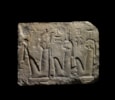Relief Fragment
Relief Fragment
19th to 20th Dynasty 1292 to 1075 B.C
Egypt.
Limestone
H: 37.5cm W: 28.9 D: 3.8cm
Sold
A fragment of indurated limestone carved in sunk relief. A row of three shrouded deities are depicted seated, facing left, each wearing a broad collar and characteristic crown. Osiris is shown with pharaonic beard and his typical feathered atef crown. Isis sits behind him with a throne-like hieroglyph on her head. Nephthys then follows, wearing a headdress in the shape of a house and basket. The field between the figures is inscribed with hieroglyphs. Traces of red pigment remain on the stone.
Nephthys and her sister Isis were often paired in funerary rites in their roles as protectors of the mummy and the god Osiris, who presided over the underworld as judge and lord of the dead. According to the Osiris myth, it was Isis and Nephthys who cared for the god’s body after his murder at the hands of Set, and who protected his son Horus while he grew up. The trio are frequently depicted together in papyrus paintings, as seen in the Book of the Dead for the Chantress of Amun Nauny (c. 1050 BC) in Metropolitan Museum of Art, New York (30.3.31).
The Private Collection of Elbert E Farman (1831-1911), Bath, New Hampshire
The Private Collection of Darius Ogden Mills (1825-1910), Millbrae, California
The Metropolitan Museum of Art, New York, given by the above in 1904 (accession number 04.3.532)
Private Collection, acquired from the above in 1959 (144.S)
Thence by descent.
ALR: S00229314, with IADAA Certificate, this item has been checked against the Interpol database.
Elbert Eli Farman (1831-1911) was born in 1831 at New Haven, Oswego County, New York, and studied law after graduating from Amherst College. His studies in criminal, international, and civil law served him well in his position as ambassador and consul general of the United States in Egypt between 1876 and 1881. He also went on to work as Judge of the Mixed Tribunals of Egypt and served as a member of the International Commission. A firm abolitionist, Farman was involved in the freeing of at least fifteen slaves during his time in the Egypt.
Farman was instrumental in negotiating the gift of Cleopatra’s Needle, the ancient obelisk which now stands in Central Park, for New York. As both London and Paris had previously received monumental obelisks, Farman wanted to secure an equivalent gift for the United States. His work with the Khedive of Egypt and his successor meant that Cleopatra’s Needle, unlike the London and Paris obelisks, was gifted freely.
During his time as consul general, Farman gathered a wide collection of ancient coins, scarabaei, bronzes, porcelain, and other antiquities.
Darius Ogden Mills (1825-1910) was born in 1825 to a well-established family in Salem, New York. He moved to Sacramento in the late 1840s, following the California Gold Rush. Within his first year as a shopkeeper, Mills turned his $5,000 investment into $40,000 in profit. His ventures in railroads, investing, and mining made him the richest man in California at one point. Mills co-founded the Bank of California in 1864 and, after the bank collapsed in the 1870s, returned to serve as President for three years without pay to restore it to its former stability. His estate occupied 500 acres of the Rancho Buri Buri near San Francisco; the town of Millbrae now on this site still bears his name today.
Mills was also known for his philanthropy. He developed three hotels to cheaply house poor men, starting with ‘Mills House No. 1’ at 160 Bleecker Street, New York. His aim in this was to “encourage men of limited means to practice economy by enabling them to live comfortably at a very small outlay”.
Mills served as president of the New York Botanical Garden, and a trustee of the American Museum of Natural History, American Geographical Society, Carnegie Institute, and the Lick estate and observatory. He donated much of his collection of antiquities and art to the Metropolitan Museum in 1904.










 Enquire
Enquire




